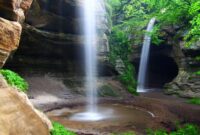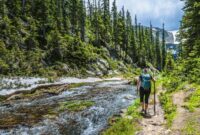Hiking mountains near me opens a world of outdoor adventure, catering to diverse experience levels and motivations. Whether you’re a seasoned mountaineer seeking a challenging ascent or a beginner looking for a leisurely nature walk, the search for nearby mountain hikes offers a wealth of possibilities. This exploration delves into the factors influencing your search results, the best ways to present trail information, crucial safety considerations, and the breathtaking visual experiences that await you on your journey.
Understanding user intent is paramount. Different searchers have varying experience levels and goals—some might seek strenuous climbs, others gentle trails. Location is key; accurate mapping and geographically relevant results are essential. Presenting trail information clearly, with visuals like elevation profiles and icons denoting features, is crucial for user engagement. Finally, safety tips and preparedness advice are critical for ensuring a positive and safe hiking experience.
Understanding User Intent
The search phrase “hiking mountains near me” reveals a user actively seeking outdoor recreation opportunities within their immediate vicinity. However, this seemingly simple query masks a surprising degree of variability in user intent, encompassing diverse experience levels, motivations, and desired hiking experiences. Understanding this nuance is crucial for providing relevant and helpful information.
The motivations behind searching for nearby mountain hikes are multifaceted. For some, it’s a desire for physical fitness and a challenge; for others, it’s a pursuit of scenic beauty and tranquility. Still others might be looking for a social activity, a way to connect with nature, or even a means of stress reduction. These varying motivations significantly influence the type of hike a user might be looking for.
Types of Hikers Implied by the Search Query
The search term “hiking mountains near me” encompasses a broad spectrum of hiking styles and experience levels. It could represent seasoned mountaineers planning a challenging ascent, experienced hikers seeking a moderate day trip, or novice hikers embarking on their first mountain trail. Furthermore, the search could be from individuals hiking solo, small groups of friends, or even families with children. The specifics of the intended hike will vary drastically depending on these factors. For example, a seasoned mountaineer might be searching for technical climbs and challenging terrain, while a family with young children would likely be searching for shorter, less strenuous trails with easily accessible viewpoints.
Motivations for Searching for Nearby Mountain Hikes
Users searching for “hiking mountains near me” are driven by a variety of motivations. These motivations can be broadly categorized as: physical fitness, stress relief, scenic appreciation, social connection, and personal exploration. Someone prioritizing fitness might seek challenging trails with significant elevation gain, while someone looking for stress relief might prefer a gentle, contemplative walk through a wooded mountainside. Those seeking social connection might be looking for popular trails suitable for group hikes. Finally, personal exploration could motivate a search for less-known trails offering a sense of adventure and discovery. Understanding these motivations allows for tailored recommendations based on individual preferences.
Experience Levels of Users
The experience level of users searching “hiking mountains near me” ranges significantly, from complete beginners to highly experienced hikers. Beginners might be looking for easy, well-maintained trails with minimal elevation gain, while experienced hikers might seek more challenging routes with technical elements. Families with children will generally prefer shorter, easier trails with less steep inclines and readily available water sources. This wide range of experience levels highlights the need for providing information that caters to diverse skill sets and physical capabilities. Search results should therefore incorporate filters or sorting options that allow users to easily find trails appropriate for their skill level.
Location-Based Search Results
Finding nearby mountain hikes requires a search engine to understand your location and present relevant results. The accuracy and usefulness of these results depend heavily on several interacting factors, impacting the overall user experience. Effective location-based search hinges on providing the most relevant trails within a reasonable distance, considering factors such as difficulty, length, and elevation gain.
Factors influencing the relevance of mountain hiking search results are numerous. Proximity to the user’s location is paramount; a trail hundreds of miles away is less relevant than one a few miles away, even if it’s objectively a better trail. User preferences, such as desired difficulty level (beginner, intermediate, expert), trail length, and elevation gain, also significantly affect relevance. Furthermore, the availability of real-time data, such as trail conditions (e.g., snow, ice, trail closures) and weather forecasts, significantly impacts a trail’s relevance at a given moment. Finally, the popularity and user reviews of a trail contribute to its perceived relevance and desirability.
The Importance of Accurate Location Data and Map Integration
Accurate location data is fundamental to providing useful location-based search results. GPS coordinates, IP address geolocation, and user-provided location inputs are all crucial for pinpointing the user’s location. Inaccurate location data leads to irrelevant results, frustrating the user and potentially leading them to unsafe or inaccessible trails. Map integration is essential for visualizing search results geographically. A map allows users to quickly assess the location of trails relative to their current position, and visually compare distances and trail layouts. Interactive maps, allowing zooming, panning, and the display of additional information like elevation profiles, enhance the user experience considerably. Effective map integration also allows for the visual display of trail conditions, parking areas, and points of interest along the trail. For example, a map might highlight a trail closure due to recent wildfire activity.
Comparison of Geographic Search Result Display Methods
Two primary methods exist for displaying geographically relevant search results: map-based and list-based. Map-based displays offer a visual representation of trail locations, facilitating a quick assessment of proximity and spatial relationships. This is particularly beneficial when comparing multiple trails in a given area. However, map-based displays can become cluttered with numerous trails, especially in densely populated areas. List-based displays, on the other hand, present trails in a tabular or list format, often sorted by distance, difficulty, or popularity. This method allows for easy comparison of specific trail attributes, but lacks the immediate visual context provided by a map. Hybrid approaches, combining map and list views, are frequently used to leverage the strengths of both methods, allowing users to switch between visual and textual representations as needed. For instance, a user might initially view a map to select a region of interest, then switch to a list view to compare specific trail characteristics within that region.
Sample Search Results
| Trail Name | Difficulty | Distance (miles) | Elevation Gain (ft) |
|---|---|---|---|
| Eagle Peak Trail | Moderate | 5.2 | 1200 |
| Sunset Ridge Trail | Easy | 2.8 | 500 |
| Granite Mountain Trail | Difficult | 8.7 | 2500 |
| Hidden Falls Trail | Easy | 1.5 | 200 |
Trail Information Presentation
Presenting trail information clearly and concisely is crucial for a positive user experience. Effective presentation ensures hikers have the necessary data to make informed decisions about their hike, enhancing safety and enjoyment. This involves a strategic combination of text, visuals, and user-generated content.
Key Trail Information Format
A well-designed trail information page should prioritize ease of understanding. Essential information should be prominently displayed at the top, followed by more detailed descriptions. A consistent format across all trails allows for quick comparisons. Consider this structure:
- Trail Name: [Trail Name]
- Location: [Location with map coordinates]
- Distance: [Total distance in miles/kilometers]
- Elevation Gain: [Total elevation gain in feet/meters]
- Estimated Hiking Time: [Time estimate, accounting for variations]
- Difficulty: [Easy, Moderate, Hard, with a brief explanation of what that means for this trail]
- Trail Type: [Loop, Out-and-back, Point-to-point]
- Permits/Fees: [Information about necessary permits or fees]
Visual Representations of Trail Difficulty and Elevation Profiles
Visual aids significantly improve understanding. A simple color-coded system for difficulty is highly effective. For example, green could represent easy, yellow moderate, and red difficult. Elevation profiles, best represented as line graphs, clearly show changes in elevation along the trail. The x-axis represents distance, and the y-axis represents elevation. Steep inclines are easily identifiable as sharp increases in the line, while gentler slopes appear as more gradual increases. A well-designed elevation profile should also clearly mark significant landmarks along the trail, like viewpoints or water sources.
Use of Icons and Symbols to Communicate Trail Features
Icons are a powerful tool for quickly communicating key trail features. A standardized set of icons should be used consistently across all trail descriptions. For instance, a water droplet icon could represent a water source, a mountain peak icon could signify a viewpoint, and a tree icon could indicate a shaded section. These icons should be placed strategically within the trail map and information section.
Trail Reviews and User Ratings Structure
User-generated content is invaluable. Reviews should be easily accessible and clearly structured. Each review should include a star rating (e.g., 1-5 stars) and a text section allowing users to describe their experience. The average star rating should be prominently displayed. Reviews could be sorted by date, rating, or helpfulness. Moderation of reviews is essential to ensure accuracy and prevent inappropriate content. Consider including a section for users to report inappropriate or inaccurate reviews.
Closure
From planning your hike to enjoying the stunning vistas, exploring mountains near you offers a rewarding escape into nature. Remember to prioritize safety, respect the environment, and choose trails appropriate for your skill level. With careful planning and preparation, your next mountain adventure promises breathtaking scenery, physical challenge, and a deep connection with the natural world. So, lace up your boots and discover the majestic peaks waiting just around the corner!




